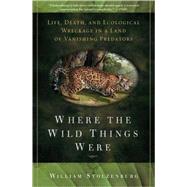
Big, fierce animals have a noble champion in William Stolzenburg.Edward O. Wilson, Professor Emeritus, Harvard University Wildlife journalist William Stolzenburg follows in the wake of natures topmost carnivores and finds chaos in their absence. His startling tour through the bizarre, impoverished landscapes of pest and plague provides a world of reason to think again about meat-eating beasts so recently missing from the web of life. Includes a new afterword by the author. William Stolzenburg has studied predator control techniques, monitored endangered species, and written hundreds of magazine features and columns on the science of rarity and extinction for Nature Conservancy and Science News, among others. He lives in Shepherdstown, West Virginia. It wasn't so long ago that wolves and great cats, monstrous fish and flying raptors ruled the peak of natures food pyramid. Not so anymore. All but exterminated, these predators of the not-too-distant past have been reduced to minor players of the modern era. And what of it? Wildlife journalist William Stolzenburg follows in the wake of natures topmost carnivores, and finds chaos in their absence. From the brazen mobs of deer and marauding raccoons of backyard America to stream-sides of Yellowstone National Park crushed by massive herds of elk; from urchin-scoured reefs in the North Pacific to ant-devoured islands in Venezuela, Stolzenburg leads a startling tour through bizarre, impoverished landscapes of pest and plague. This provocative look at how the disappearance of the worlds great predators has upset the delicate balance of the environment also tells of what their disappearance portends for the future. Absorbing and delightful . . . Where the Wild Things Were is one of those rare books that provide not just an enriching story, but a new, clarifying lens through which to understand the world around us.Christian Science Monitor Stolzenburg narrates these cautionary tales with a conservationist's attention to ecological detail and a childlike reverence for flesh-eating beasts. His infectious enthusiasm should spark even in bug-wary urbanites a renewed appreciation for natures complexity.Time A meticulous and convincing argument that alpha predators are the primary regulators of ecosystems, and that their removal is crippling our planets biodiversity.Bill McKibben, Boston GlobeWith a lucid and sparkling voice, William Stolzenburg offers a revealing and well-documented account that explains clearly why we need the wolf, tiger, and other predators, large and small, to maintain a healthy environment.George B. Schaller, Vice President of Science and Exploration, Wildlife Conservation Society; author of The Serengeti LionWhere the Wild Things Were is science writing at its best. The subject is important for biology and sustainable development, the prose is excellent, turning lyrical at just the right times, and the story of the research is woven with clarity into natural history. Big, fierce animals have a noble champion in William Stolzenburg.Edward O. Wilson, University Research Professor Emeritus, Harvard UniversityAs the title implies, this work is an examination of a world without the top predators of an ecological niche. Exploring the history of predation from the first microscopic predator through the age of the dinosaurs to today's modern mammals, science writer Stolzenburg, who has studied predator-control techniques and monitored endangered species, reveals the devastating ecological consequences that result (e.g., marauding deer and raccoons in suburban backyards, huge herds of elk in Yellowstone Park) once a top predator is removed from its position. Throughout, Stolzenburg follows the studies of several ecologists looking at the food chain from the top down and furnishes hard-core evidence that an ecosystem is more diverse with the top predator acting as a checks-and-balances measure to provide multiple-prey species with the chance to survive. A comprehensive bibliography offers both professional and amateur ecologists, naturalists, and biologists further readings to learn more about predator-prey interactions. The easy-to-read and captivating prose will introduce readers to species of animals they've never heard of before, as well as give a greater awareness and appreciation for the complexity of the world in which we live.Kyrille Goldbeck, Library JournalIn this impassioned debut, wildlife journalist Stolzenburg examines predation's crucial role in the preservation of ecological diversity, painting nightmarish pictures of what happens when top carnivores are exterminated from ecosystems. Without sea otters to keep ravenous sea urchins in check, some ocean floors in the North Pacific have been stripped of kelp. In Yellowstone National Park, the eradication of wolves has resulted in a glut of elk that have trampled river banks and chewed down young trees. White-tailed deer have denuded the undergrowth in the forests of the eastern United States, because wolves and cougar have disappeared. Without large meat eaters, mid-size predatorsraccoons, blue jays, crows, squirrels, opossumshave proliferated, to the detriment of songbird populations. In dazzling descriptions, Stolzenburg demonstrates how the delicate balance between predator and prey is so essential, and his book, rich in dramatic accounts of life and death in the wild, is powerful and compelling.Publishers Weekly (starred review)
|